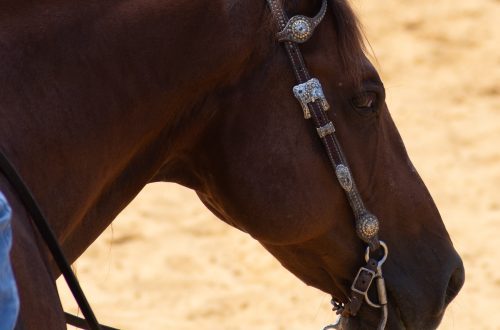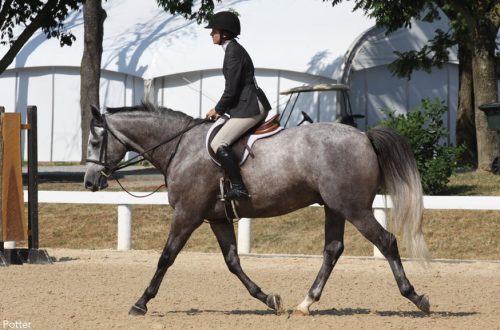
Analyzing: extended trot
Analyzing: extended trot
The trot is a two-beat gait with a suspension phase. This is the most energy efficient way for a horse to travel long distances.
The legs of the diagonal pair must land at the same time.
The front and hind legs form two equal triangles. The third triangle (in the middle, with the base on the underline of the horse) is formed by two legs, front and back, located on the same side.
Poor quality trotting can be the result of defects in the horse’s conformation, injury, pain, muscle tension, poor training and teaching methods, improper harness, rider imbalance, etc.
In the photo below you can see a decent increase (three triangles in place).

The stride length of the hind legs is identical to the stride length of the forelegs. The hoof of the hind foot drops to the ground in front of the print of the hoof of the front foot. There is a certain stiffness in the loins and shoulders (the loin should be full and rounded, the front leg should be more straight and drawn back from the shoulder).
The tightness causes the two hooves to almost collide. If the horse is more connected (works with his back instead of just swinging his legs), his back will round, his croup will drop (in the photo it is raised), the weight will shift back, and the front will lighten and rise (and loosen up).
All this would change the quality of the trot for the better and would make room for the hind legs to go deeper under the body without hitting the front with the hind hoof.

In the next photo we see a good increase in trot for a horse of a heavy or semi-heavy breed. A horse with this conformation tends to have short hindquarter strides, but this guy is a hard worker. Unfortunately, the photo was taken at an angle that does not allow us to get a clear idea of the position of the croup. The shooting angle also distorts the ability to correctly estimate the stride length of the front and hind legs. One gets the impression that the step of the hind legs is wider than the front. Some of the differences between these two photographs have to do with the tight extensors. The left forearm is in front of the vertical, and the carpal joint is bent more than in the first photo. Less tightness allows the wrist to go back and the leg to straighten, which creates a wider stride and triangle.

The hauler stretches farther with its right front than the saddle horse in the first photo. Compare where the right front hoof is on both horses in relation to their noses. Both horses have equally short necks, so this is not the case when we can say that everything depends on the neck. Both horses also have the same shoulder angle, so the shoulder is also not the cause of the difference in forward reach. What is different is the shoulder angle. For a heavy truck, it is 105 degrees, while for a riding horse it is 98.
Also, due to the angle of the shot, it seems that the heavy truck is stepping with its back foot to a point under its withers, and the riding horse reaches only to a point under the middle of its back. Keep in mind that the shorter back of the heavy truck can also affect this.
We also see some violation of the cleanliness of the draft lynx. His right hind foot is still on the ground, while his front foot has long been in the air, and his left hind foot has dropped before his right fore foot. But I don’t feel like blaming this powerful horse for not being very good with its hind legs. A little stretching and relaxation work and her trot will be much cleaner.


Now look at the extended trot from the position of many dressage riders.

There are so many errors here that I don’t even know where to start.
1. Obvious discrepancy between the stride length of the front and hind legs. The step of the hind legs is much shorter.
2. The hock joint of the pushing hind leg is outside the horse and not under the thigh.
3. The horse walks in front. This is indicated by the way the pastern of the front right leg is squished compared to the pastern of the back left.
4. The right hind leg drops to a point slightly ahead of the horse’s hip point, although ideally it should drop to a point under the rider’s seat.
The lynx is absolutely of poor quality, there can be no talk of its purity.

In this photo, we see a similar set of characteristics, plus a forward-turned hoof, as well as a left front leg almost bent backwards.

Considering the previous two photos, the horse in the next one is moving quite well, showing us a working trot of a lower level.

The horse has a shorter stride of the hind legs than the front. Why? Pay attention to how well the muscle of her neck (looks like a tube) filled up. It “flows” into the shoulder; the base of the neck is raised, as is the withers. This horse also has a bit of a lift in his back, but there is stiffness in the loin which causes tightness in the muscles of the hindquarters. If we look at the structure of her hind leg, we can see that the thigh is clearly shorter than the lower leg. What does it affect? A short hip naturally limits the length of the stride, and at some point the horse is pinched at the loin, further blocking the leg, preventing it from reaching forward. Loosen the loin and the horse can move his hind legs more freely, which will improve connection, etc., etc.

Here is another example of a working trot where the horse takes a longer step with its hind legs than with its front legs.

Her loin is just as empty and enslaved, empty and croup. The wider hind stride of this horse is (in part) the result of its over-angulated hindquarters, not the result of super connection. Here we see that the thigh is shorter than the lower leg, but in itself it is long. This is the case when the horse will often overstep the marks of the front hooves with its hind hooves, but is not really hooked up. Therefore, when someone says that his horse is stepping, it does not always mean that he moves well, or when someone prompts you by saying when the horse steps and when not, this also does not always characterize the presence of a connection. This concept is relative and depends on the structure of the horse and how he uses his body at the moment.
The most troubling sign in this photo is the horse’s misuse of the neck and tight musculature. This is an example of a horse that has been trained and worked incorrectly. She has a low exit and set neck (perhaps she has a deer neck). During her training, some kind of restraining ammunition was obviously used (a martingale, perhaps a sprunt, or both). Probably the hard hand of the rider took place. As a result of this work and training, his front is blocked and does not move freely, the horse walks on a front balance (right front foot is still on the ground, while the left hind is already in the air, the right hind lands before the right front leaves the ground ). This kills the hang phase.

In this photo, we see a horse whose trot is tightly controlled to fit the “tournament limits”. And it’s not for the best.

Although it is seen that the front legs take wider strides than the hind legs, both the front and hind legs are shortened by poor training and riding so that the horse does not close the middle triangle of the trot. Finally, we see a horse whose thigh and lower leg are the same length. This is what we are looking for. A horse with this build has the potential to tread deep under the body with its hind legs. But there are exterior issues that have been encouraged and exaggerated – overbuilt (rear higher than front) and low neckline and setback. Apart from and in spite of these features, there is no reason why this horse should move so badly (on the forehand, not enough suspension). There is only one reason – her rider and his ignorant work. Note that the lowered head here is not the result of lifting the base of the neck (the horse is trying to do it right). This is “lowering the head down into a grazing pose.”

And now let’s look at the work of Western riders …

The front legs take wider steps than the hind legs. The reason is the horse in the front (rebuilt). Much of what we see in this photo depends on the build of the horse. The horse has a set hind quarters and a closed angle of the shoulder, which shortens its stride. The joints of the legs do not flex sufficiently, there is no suspension phase. But it’s not all bad. This is one of the best moving Western Pleasure horses I have seen in a long time (in the conformation that the breeders made it into).

In the photo below we see a Western Pleasure horse with a cleaner trot. In practice, one can even observe a suspension phase in it. The horse is in the forehand, but this is not so bad, given its rebuilding and set back hindquarters. This horse uses his body quite well under the circumstances. Pay attention to the line of contraction of the abdominal muscles. Very weak muscle definition tubular complex indicating a rise in the base of the neck. These lines would be more visible if the horse was encouraged to seek contact and worked to loosen the jaw and occiput.

Translation by Valeria Smirnova (a source).





